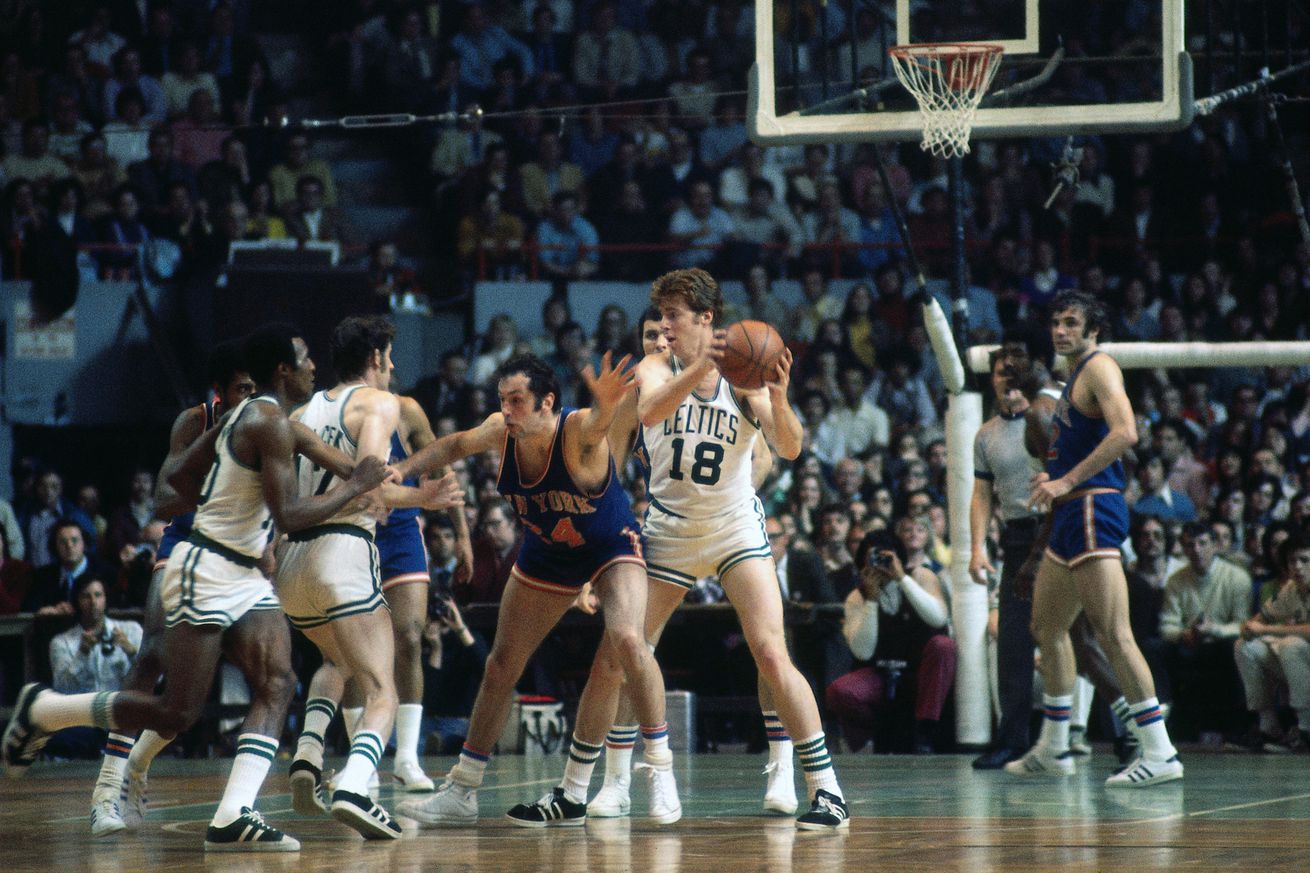
Boston vs. New York has been going on for eight decades and is rich with historical lore both on and off the court
The Boston Celtics have no shortage of rivals across the NBA. Those that would immediately come to mind for most fans would be the Lakers, the Sixers, perhaps the Warriors, and definitely the Heat. But the longest-running rivalry – and for a while in the 1970s, the absolute hottest one of all – is between the Celtics and their next playoff opponent, the New York Knicks.
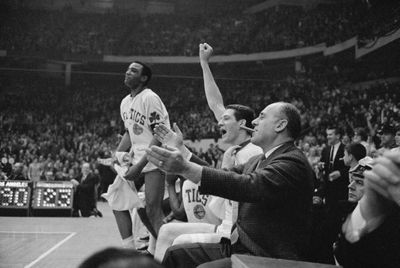
The Knicks? But the Knicks haven’t met the Celtics in the postseason since 2013, and only twice since 1990. Plus, the Celtics have 18 titles in their 79 seasons. The Knicks have two. Why are they rivals?
Because they have history. They have beef that goes much further than the standard Boston vs. New York feud. We’re talking about the Knicks trying to steal Red Auerbach away from Boston; epic double-digit win streaks against each other; five playoff meetings in an eight-year period when both teams were legitimate title contenders; the Celtics capitalizing on a Knicks draft error that changed the trajectory of both franchises; and a surprising number of ex-Knicks who left New York and won titles in Boston.
Their rivalry was meant to be. The Celtics and Knicks were both founded in 1946 when the Basketball Association of America – the forerunner of the NBA – was formed. They are the only two teams still playing in their original cities and using their original nicknames. As you might guess, they’ve played each other in more regular season games than any other matchup — 498 times — with Boston dominating at 308 wins to 190 losses.
The playoffs, however, are almost even. They’ve played 15 series, the Celtics winning eight. Boston holds a slim 36-31 lead in playoff games head-to-head. And to be honest, the Knicks have gotten the best of the Celtics more often than just about anyone. But Celtics fans still have all the bragging rights in this matchup because, as mentioned, New York’s (Madison Square) Garden has just two championship banners and (Boston/TD) Garden has 18.
So, what are some of the events that created bad blood between the two franchises? First, the most impactful.
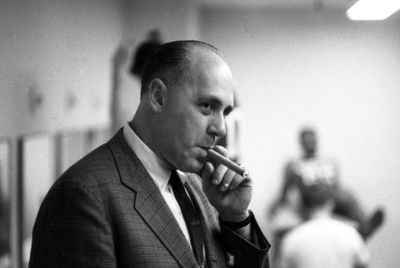
Set Number: X9176 F11
Stealing Red
In the summer of 1978, Red Auerbach’s contract was expiring and the Celtics were in turmoil with a volatile new owner, former Kentucky governor John Y. Brown. The Knicks came after Red with the largest contract ever offered to a team executive. Red was tempted, but according to Celtics folklore, pleas from various taxi drivers and people on the street helped him decide to stay with the Cs.
Just for comparison, imagine what would you say if the Knicks tried to recruit Brad Stevens today.
McAdoo trade
Not long after that, John Y. didn’t bother to consult Red before trading three first-round picks to New York for high-scoring center Bob McAdoo. Red didn’t want McAdoo any more than the All-Star wanted to be in Boston. After the season, Red salvaged the situation by shipping McAdoo to Detroit for some picks that eventually turned into drafting Kevin McHale and trading for Robert Parish. Needless to say, the Knicks didn’t get anyone like that with Boston’s three picks.
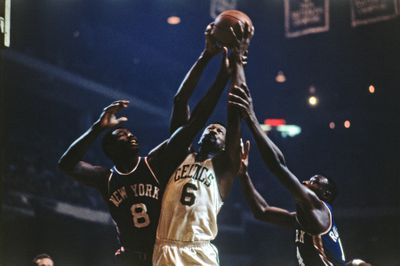
Photo by Dick Raphael/NBAE via Getty Images
1967-74
The most intense period of the rivalry occurred in these years. In ’67, the Knicks were the young and improving future contender, comparable to Detroit or Orlando today. They lost to the Celtics 3-1 in the first round. In 1969, they looked like title threats but still had to wait their turn as they lost in six to Bill Russell’s veteran squad, which then beat the Lakers for the title.
After Russell and Sam Jones retired, the Knicks ruled the East, making the Finals in three of four years and winning the 1970 and 1973 titles (still their only banners). Fortunately, in hindsight, New York beat the Lakers both those times.
Meanwhile, the Celtics rebuilt and made it to the Eastern Conference Finals in 1972 and 1973 — only to lose to the Knicks both seasons. The ’73 series was the most frustrating. The Cs were 68-14 that season, best in franchise history. But captain and leading scorer John Havlicek injured a shoulder early in the NY series and Boston fell behind 3-1. They lost Game 4 in double overtime after the Knicks rallied from down 17 with the help of about a dozen straight calls against Boston in the fourth quarter. The Celts came back to force Game 7, only to lose it at home — the first time that had ever happened.
In 1974, the Celtics broke through, needing just five games to take down the Knicks in their third straight Eastern Conference Finals meeting. They raised Banner 12 that year. The tally for the eight seasons: five playoff meetings, three won by Boston; two NBA titles won by each franchise,
Other notable rivalry factors:
Losers with Knicks, winners with Celtics
Auerbach had a knack for finding useful players who’d been cut by other teams, especially ex-Knicks. Carl Braun and Willie Naulls were multiple-time All-Stars in New York. Braun came to Boston for his final season and retired as a champ. Naulls won three rings after coming over, and also made history as a member of the NBA’s first all-black starting five. Former #1 overall pick Jim Barnes played backup center and Emmette Bryant became the starting point guard on the 1969 title winners.
Two current Celtics champs are former Knicks Kristaps Porzingis and Luke Kornet.
Sam’s 50-Piece
In 1967, Sam Jones hit the Knicks with 51 points to lead a closeout win at MSG. It set a Celtics playoff record until Havlicek scored 54 six years later.
Clyde vs. JoJo
During the late ‘60s and early ‘70s, Walt “Clyde” Frazier was the Knicks’ smooth point guard, a lethal scorer and ball hawk defender who could do no wrong in the eyes of the powerful New York media. JoJo White was the classy point guard of the Celtics, an iron man who never missed a game and rarely missed with his deadly jump shot. Both were stylish All-Stars who became two-time NBA champs and who epitomized their respective franchises as the class of the league. Clyde generally was considered the better of the two, but only JoJo won an NBA Finals MVP.
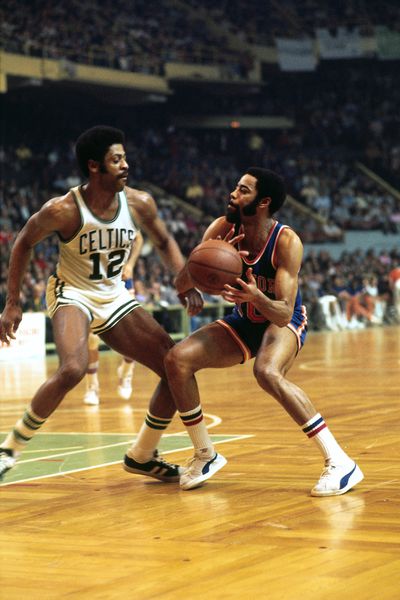
Photo by Dick Raphael/NBAE via Getty Images
Red blocks Knicks pursuit of free agent McHale
In 1983, Kevin McHale’s contract expired and the Knicks pursued him in free agency. Auerbach wasn’t losing him without a fight. The salary cap was new then, and Red used it as a weapon, signing three Knicks free agents to contract “offer sheets.” The Knicks couldn’t then sign McHale and also match the contract offers to keep a huge chunk of their rotation. Kevin stayed, Red won again.
Knicks pass on Bird
In 1978, the Knicks drafted point guard Michael Ray Richardson at #4. The Celtics picked Larry Bird at #6. Richardson became an All-Star and defensive menace. But he was no Larry Bird. Now just imagine if those two stars had switched places.
King vs. Max (and Bird), 1984
The best series between these rivals was the 1984 Eastern semifinals, which Boston won 4-3. The home team won every game, Boston by 14 or more every time and New York by single digits in theirs. Wild moments included a Danny Ainge vs. Darrell Walker brawl and the Celtics missing eight straight free throws that killed a fourth-quarter comeback attempt in Game 3.
Bernard King, the Knicks’ top offensive threat, had been on a scoring binge, and before Game 4, Cedric Maxwell loudly (and profanely, in his way) vowed that King would not score 40 on him. Unfortunately, King responded with 43 to even the series 2-2. But in the end, Larry Bird was the unstoppable force, averaging 30.4 points per game, topping King’s 29.1.
Winning streaks vs. each other
In two seasons spanning 1965-67, the rivals faced each other 23 times, including a playoff series. The Celtics won the first 21 straight, and lost just one of the 23.
From 1993 to 1998, the Knicks returned the favor by beating Boston 21 straight times.
Knicks’ impossible comeback
In the 1990 first round, the Celtics scored 157 points to take a 2-0 lead in a best-of-five series. That’s still an NBA record today. But the Knicks stayed alive with a three-point win in Game 3 and a rout in Game 4. Game 5 was in Boston, where the Celtics had beaten the Knicks 26 consecutive times. Unbelievably, the Knicks took the lead in the third quarter and never gave it back. Key plays in the fourth quarter were Bird’s missed dunk and a dagger three to beat the shot clock by New York center Patrick (Not a 3-Point Shooter) Ewing to beat the shot clock.
They wouldn’t meet again in the playoffs until 2011, which was a four-game sweep by Boston.
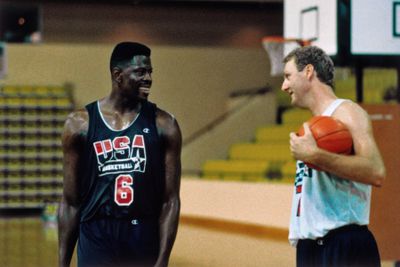
Photo by Andrew D. Bernstein/NBAE via Getty Images
Larry and Harry
Despite their battles on the court, Bird and Ewing became fast friends while on the Dream Team together at the 1992 Olympics. The duo was dubbed “Larry and Harry” by their amused Dream Team brothers.
Pierce owned the Knicks
In his Hall of Fame career, Paul Pierce scored 1,323 points versus New York – his high against all opponents. This hoop is perhaps his most memorable, including bonus Nate Robinson.
2013 near comeback, and the end of an era
After falling behind 3-0 in the first round, the Celtics fought back to force a Game 6 in Boston. But the Knicks looked safe when they built a 26-point lead early in the fourth. Hold on – the Celtics suddenly reeled off 20 straight points, and as the clock ticked down, got as close as four points. New York steadied the ship and held on to end the series. Pierce, Kevin Garnett and Jason Terry were traded to Brooklyn after that season.
As you can see, a lot has happened during 79 seasons – and we didn’t even discuss all the fights, the Honey Nut Cheerios incident (Google that one), Rick Pitino coaching both teams, and many more topics.
It’s good that the Celtics and Knicks are meeting in the playoffs after a 12-year hiatus. The rivalry needs new blood. This series is guaranteed to be heated, physical and annoying. Spike Lee and the MSG crowd will definitely bring the hate. Jalen Brunson will flop. Before it’s over, Celtics fans, you’ll be adding this rivalry to your list.